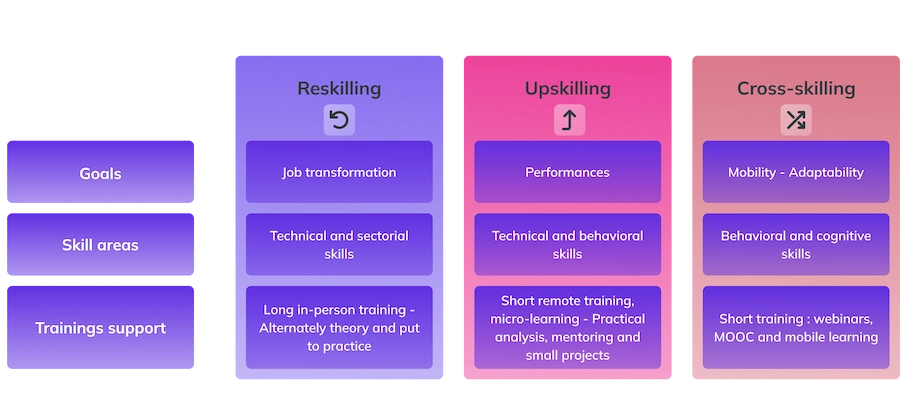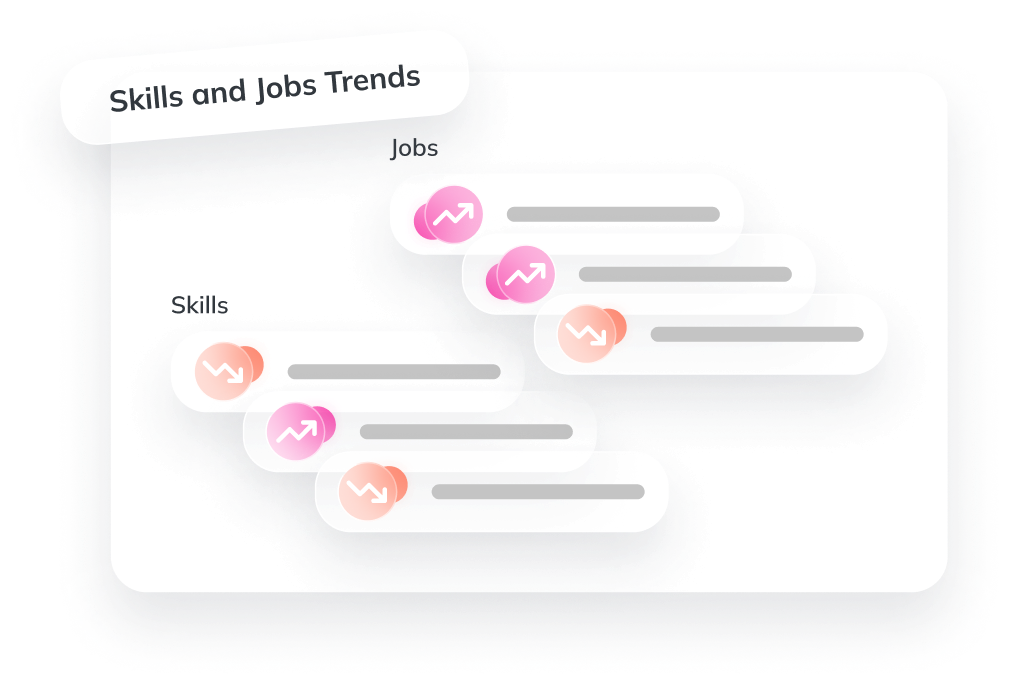In today’s business environment, there are 3 main challenges that make reskilling the number 1 issue for HR teams:
- Increased operational costs (the cost of a workstation has risen by 9.4% for French companies” (Figures: Idet 2023) ,
- Opportunities to automate a growing number of activities within business lines
- Transformation of skills, whether technical or not
.webp)
Upskilling and Reskilling: what are the main differences?
It is interesting to explain the difference between upskilling and reskilling, and the definitions of reskilling and then present their importance in an HR strategy.
- Upskilling involves various support strategies aimed at enhancing current skills for a similar role.
- Reskilling consists of training resources aimed at providing individuals with new skills to ensure their employability, people are likely to move to new jobs.
In fact, these types of training are increasingly integrated into HR strategies, as 56% of companies foresee a deficit of skills and general ability which could lead to a loss of productivity and economic value. The automation of certain tasks is one of the origins of these types of training; in a recent survey, 53% of respondents were aware that this will have a strong impact on their daily activity.

Step 1: Map existing skills
The health crisis situation caused by the COVID-19 pandemic forced many employers to rethink their HR strategy: considering employability in the age of obsolescence, a reduction of technical skills, disenchantment of work, the changes incurred by the advancement of AI and general digitalization and retention of resources.
Thus, upskilling or reskilling plans are the immediate solutions that can help to face these HR challenges. In practice, you need to start by mapping the existing skills in the company for which you are the HR director. It allows you to adapt to resources that are sometimes over- or under-subscribed. It also plays a vital role in the implementation of an HR information system and the optimal HR upskilling strategy.Mapping skills through a dedicated software will enable you to to draw up a table that gathers the skills and professional qualities of a specific department or a company as a whole. It is also capable of identifying upskilling and reskilling needs.
The mapping of the current skills of your employees is therefore the basis of the training areas to be considered. The evaluation of the different HR actors will objectify this mapping, we dedicate a complete article to the reliability of skills: the 5 good practices to make your reference systems reliable.
Step 2: Project skills into the future
Opting for skills management solutions, for example, allows the deployment of upskilling and reskilling plans. Such a tool ensures the formalization of the mapping of skills and provides companies with the means to subsequently create scenarios for the evolution and internal mobility of workforce employees over time (Strategic Workforce Planning). The modernized version of forward-looking employment management skills needs a backbone provided by the initial mapping. It facilitates adaptability, and versatility and helps to future-proof the digital transformation of many organizations.

Step 3: Get your digital platform adopted
Digital learning differs from e-learning through its pedagogical methods, its technological tools and the human support it can boast. Indeed, this strategy allows for the deployment of upskilling or reskilling plans in a company undergoing rapid change.
Digital learning combines moments of self-training through digital tools and moments of human follow-up at a distance or in person. One example is blended learning, which ensures the online evaluation of the learner’s knowledge through regular quizzes.
The three trends in digital learning:
– Adaptive learning.- Microlearning- Immersive training
Step 4: Strengthen your approach iteratively
Talent management is a solution for analyzing the company’s strategy and the content of the jobs in order to adapt the skills of your current employees. Thus, for each new job or project, a profile of experience, skill and performance is defined.
To carry out your upskilling or reskilling plan, it is important for leaders to implement a better talent management strategy and to use appropriate software. This software must ensure the integration of talent in order to facilitate the work of HR in the training, recruitment, evaluation, compensation and career management of employees and collaborators of an organization.
In addition, the technology available offers a simplified and global response and constitutes analysis and decision tools that help you at each stage with the deployment and completion of your plan.
It evolves into a valuable tool to enable ongoing conversation between employees and managers, continual assessment of individual and team performance. Ultimately the result is an immediate identification of hidden insights and potential risks.
Is managing your talent and developing new skills one of your priorities? Let’s explore how AI can enhance your actions.







